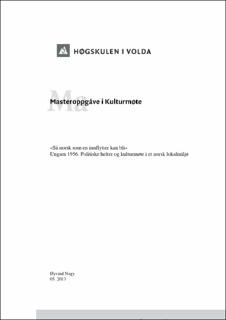| dc.description.abstract | On October 23, 1956 demonstrations arose in Hungary's capital, Budapest. The demonstrations were largely started by working youth and students, but soon up to 200 000 people attended in which degenerated into pure war. After a few days of Hungarian progress, the Hungarians' war luck turned, as Russian tanks invaded Budapest early morning on November 4. The Hungarians now suffered a crushing defeat.
An estimated 20,000 Hungarians were killed in these battles, while some 200 000 fled. 1500 of these 200,000 Hungarian emigrants, landed in Norway, where they at first were placed in transit camps. Twelve of the refugees, got a short stay in the Tveit camp near Kristiansand, before finally finding their way to the small town of Flekkefjord in Vest - Agder, where they arrived on January 5 1957.
This study revolves around the adaptation of Eastern European immigrants of the Cold War into the Norwegian society. The focal point of the study, will be the cultural meeting between a small selection Hungarian refugees of 1956 and the small town of Flekkefjord. The emphasis should be on different sides of their socialization process in a local context. As five of Flekkefjors twelve Hungarians traveled on, my informants is constituted by the seven immigrants who remained in this local community.
I place my study in a mixed category, as it involves the disciplines of history, anthropology and sociology. Furthermore, this study will operate with quite a few facets at a theoretical level. The topic will be addressed on the basis of a theoretical base, formed by the historical oriented sociologist Norbert Elias and by the social anthropologist Fredrik Barth. In a sense, i therefore operate by two slightly different theoretical basis. Firstly, it is a question whether there are grounds for claiming that it was a form of us - them relationship or whether the Hungarians experienced any form of systematic discrimination by the Norwegians. On the other hand, a key issue is how the refugees themselves perceive their own identity and belonging, after more than fifty years in Norway.
There will also be a small part study about whether one can find evidence that second generation, the descendants of Flekkefjords 1956 Hungarians, show signs of cultural membership in the Norwegian society. The theoretical basis of the study of the second generation, are associated with the French sociologist Pierre Bourdieu's concepts of habitus and capital. | en_US |
